The kumquat tree is a small evergreen shrub that produces small sweet and tart citrus fruits. Kumquats, also known as cumquat, have thin skin which is sweet while the flesh of the fruit is sour. Eating a kumquat fruit whole, skin and all, the flavor is an exciting explosion on your taste buds! Learn how to grow kumquats with our guide to kumquat tree care.

Kumquats are grown as both an ornamental tree and a food-producing tree. The fruit can remain on the tree for an extended time making them attractive trees in the garden. While dwarf varieties are ideal for growing in pots or containers so in cooler climates they can be moved indoors during the winter.
Table of Contents
- Kumquat Tree Care
- 6 Steps To Planting A Kumquat Tree
- Fertilizing Kumquat Trees
- Varieties: Types Of Kumquat Trees
- When Does A Kumquat Fruit?
- How Long Does It Take A Kumquat Tree To Produce Fruit?
- How Do You Know When A Kumquat Is Ripe?
- How Do You Eat A Kumquat
- Can You Grow A Kumquat Tree From Seed
- Pests And Disease
- Conclusion
- Recommended Products
Kumquat Tree Care
Kumquat trees (botanical genus Fortunella) are hardy trees once established. They are known to be drought and cold-tolerant as well as pests and disease resistant. They tick all the right boxes for a fruit-producing tree to grow at home. So let’s learn more about the kumquat trees ideal growing conditions and how best to care for them.
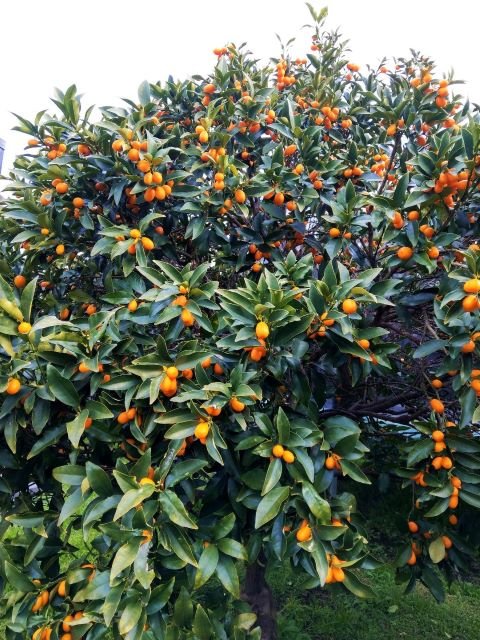
Climate: Where Do Kumquats Grow
Kumquat trees prefer a warm climate though they are cold hardy to 18°F (-7°C). The warmer the climate, the sweeter the fruit will be. They can also grow in temperatures that reach 100+°F (38+°C).
In the US kumquat trees can be grown in zones 8b-11 in the ground, otherwise, they do best grown in warm temperate and subtropical climates.
Soil Requirements for Growing Kumquat Trees
Kumquat trees will grow in many soil conditions but they do prefer a neutral soil pH.
Good soil drainage is important to ensure the roots do not rot. So while many soil conditions will be adequate, heavy clay soil will be problematic. Consider a raised garden bed or large pot with good drainage holes instead.
Sun Requirements for Growing Kumquats
Full sun is important for a healthy kumquat tree. Find a position in the garden where the kumquat tree will receive full sun for 6-8 hours or more a day. They also prefer a position with protection from the wind.
Water for Growing Kumquats
A newly planted kumquat tree needs more regular water. Depending on your climate, every second or third day for the first couple of weeks will help ensure the tree establishes itself.
Once the kumquat is established, watering can be reduced to twice a week in summer and once a week in winter. Again this will be dependant on the climate. With regular rainfall, kumquats may not require any additional water.
A good rule of thumb is to allow the top 2-3 inches of soil to dry out before watering again.
Kumquat trees grown in pots or containers will require more regular watering as they will dry out quicker than trees grown in the ground.
Growth Habit of Kumquat Trees
Kumquat trees can grow 6-16 ft high (2-5 meters) though they can be pruned to remain a smaller shrub size tree at 6 ft (2 meters). They can grow 6 ft (2 meters) wide.
Pollination of Kumquat Trees
Kumquat trees are self-fertile. You only need one tree to produce loads of delicious fruit.
If you are growing kumquat tree indoors you will need to hand pollinate the flowers as there will be no insects to do the job for you. This can be done easily with a small paintbrush. Gently brush around the flower and move onto the next flower and do the same. Continue for all the flowers on a daily basis during flowering.
Pruning Kumquat Trees
The best time to prune a kumquat tree is after fruiting although it can be done at any time outside of winter.
After fruiting is a good time to check for dead branches and remove them, prune off any suckers growing from the base, remove any crossing branches as well as remove a few branches on top to allow more light into the canopy.
Otherwise, pruning is only required if you would like to maintain a smaller size and to shape the tree.
6 Steps To Planting A Kumquat Tree
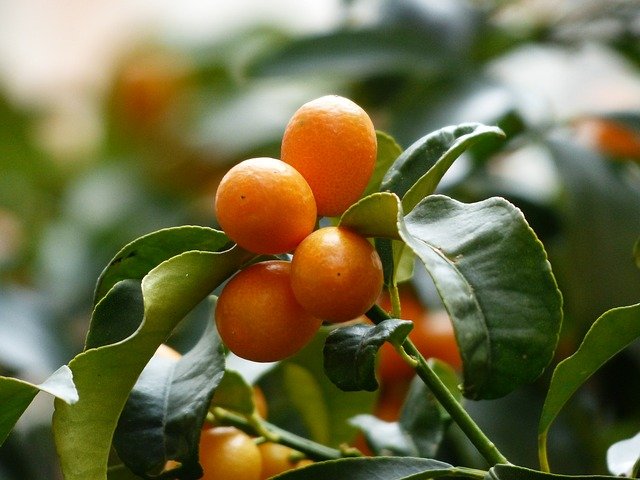
Step 1. Dig a hole twice the width of the kumquat tree container and slightly deeper than the container. The planting hole can be filled with some homemade compost, but not fertilizer as fertilizer can burn the kumquat trees sensitive roots.
Step 2. Next, remove the kumquat from the pot and very gently tease out the bottom roots.
Step 3. Then place the kumquat tree in the hole, ensuring it is planted in the ground to the same level as it was in its pot. This is important because burying the trunk any deeper can cause the kumquat to root.
Step 4. Next, fill the hole around the kumquat with soil and gently but firmly pat it down.
Step 5. Now it’s time to water the kumquat tree. Watering will help to settle the roots in the soil.
Step 6. Finally use an organic mulch with a cover of 1-2inches (3-5cm) thick. Mulching will help retain moisture and protect the soil. It is important to leave a small gap around the trunk to ensure the mulch does not touch the trunk of the kumquat tree which could otherwise cause the tree to rot.
Fertilizing Kumquat Trees
Like all citrus trees, kumquats require regular fertilization to keep them happy. Aim to feed them 3 times a year with a citrus fertilizer. The addition of compost and mulching with an organic mulch will also contribute to feeding the plant and protecting the soil. Remember to keep mulch from directly touching the trunk of the tree.
Varieties: Types Of Kumquat Trees
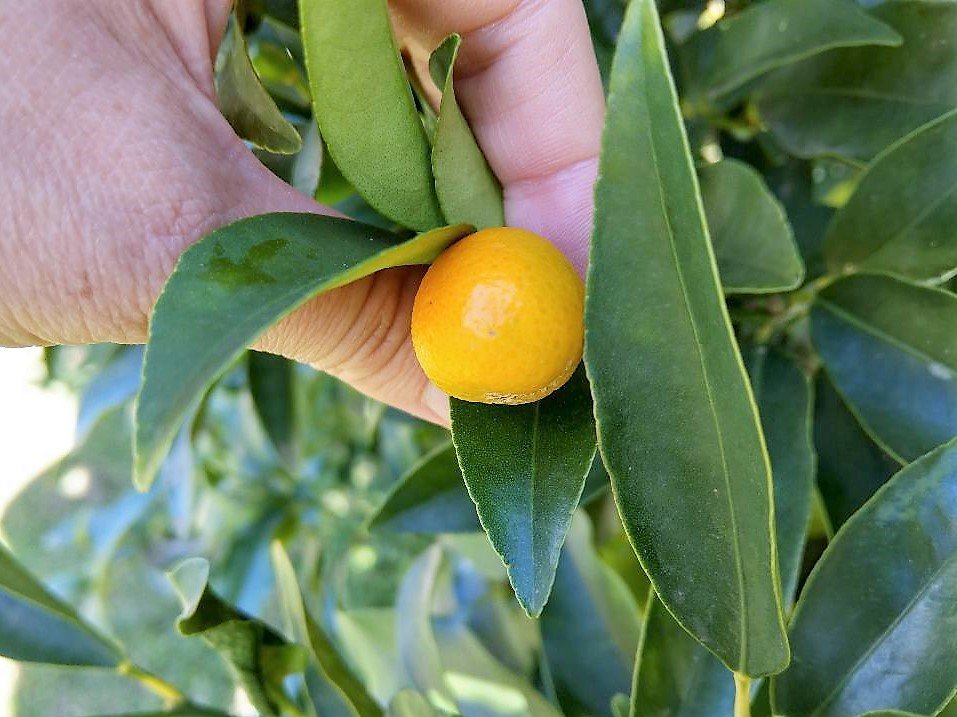
There are four more commonly known and grown kumquat varieties with Meiwa and Nagami being the most popular varieties grown in the US. While there are also many hybrid varieties grown throughout the world.
Meiwa Kumquat Tree – Meiwa kumquats are a small round fruit with thin skin. The fruit can be eaten whole and fresh from the tree. This is a hybrid of Marumi and Nagami. The fruit is sweet with both the skin and flesh tasting sweet and is commonly known as the sweet kumquat. The Meiwa
Nagami Kumquat Tree – The Nagami kumquat produces small oval-shaped citrus fruit which can stay on the tree for an extended period of time. This adds to the attractiveness of the tree and its ornamental appeal. The tree can grow 6.5-16.5 ft (2-5 meters) though it can be pruned to remain a smaller tree at 6.5 ft (2 meters). Nagami kumquat is a favorite variety for many home gardeners and the variety of kumquat I grow at home.
Hong Kong Kumquat Tree – native kumquat grown in China.
Marumi Kumquat Tree – The Marumi is similar to Nagami though it has round fruit with thinner and sweeter skin.
Hybrid varieties include various variegated types, Fukushu, Eustis Limequats, Indio Mandarinquats and Calamondin also known as Calamansi.
When Does A Kumquat Fruit?
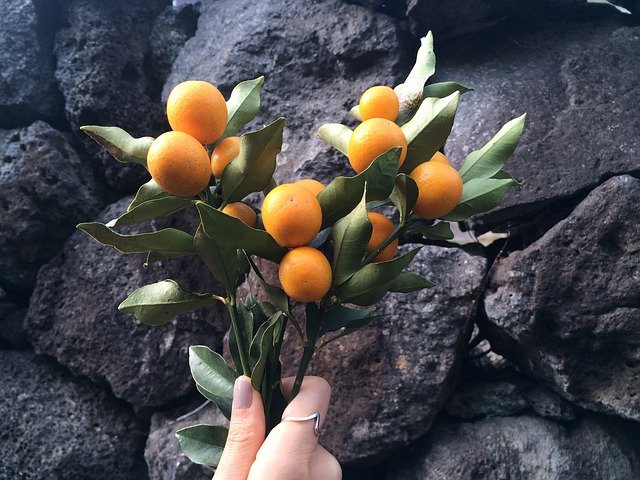
Depending on the variety, harvest time for kumquat fruit is winter through early spring.
Flowering occurs in summer, followed by fruit set in autumn and ripening in winter.
How Long Does It Take A Kumquat Tree To Produce Fruit?
Generally, you can expect a kumquat tree to produce fruit in 2-3 years. Many trees purchased from nurseries are already 2-3 years old and your tree may produce fruit in the first season.
How Do You Know When A Kumquat Is Ripe?
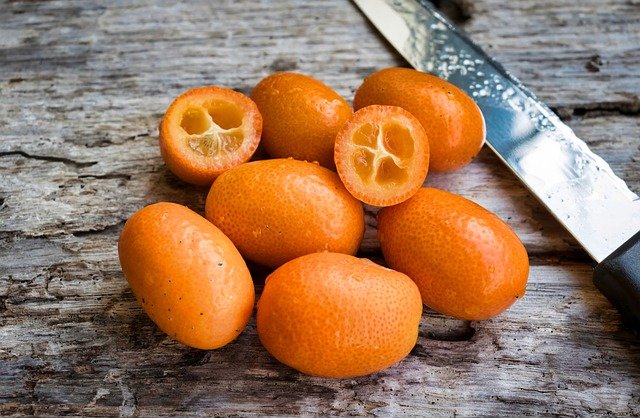
The kumquat fruit is ripe when it has changed color from green to orange all over. The fruit will be slightly soft and the color bright orange.
Once the fruit has turned orange all over, they are ready to harvest. You can do a taste test to make sure and if the fruit is too tart or hard, leave them on the tree for another week before taste testing again.
Kumquat trees can hold their fruit for a long period of time. This is one of the many reasons gardeners love to grow them; they look attractive!
How Do You Eat A Kumquat

Kumquats can be eaten whole and fresh from the tree. Though like many citruses, the seeds should be avoided if possible. They are not harmful if you do ingest them but if you manage to chew them, they can be bitter tasting. The seed from my Nagami kumquat fruit is usually small enough that I don’t worry about removing seeds.
There are also many other ways to cook and eat a kumquat, including eating them fresh. They can be pickled to use in salads, sweet pickled for a dessert served with ice cream, candied, made into a jam (our kumquat jam here is amazing ) or marmalade, chutney to accompany roast meat as well as baking and drinks.
We have more ideas in our article here for Eating Kumquat Fruit with Recipe Ideas.
Can You Grow A Kumquat Tree From Seed
Yes, you can grow a kumquat tree from seed, however, the fruit will not be reliable.
Kumquat trees purchased from nurseries and garden centers have been grafted onto root-stock which is bred to be disease-resistant. Producing a kumquat tree ready for sale in nurseries and garden centers can take 3 years.
By purchasing an established tree, your kumquat tree will produce fruit faster for you. In fact, many gardeners are pleasantly surprised to see fruit being produced in the first or second season.
Pests And Disease
Although we have detailed a fairly long list of pest, problems and diseases that can affect a kumquat tree, generally they are hardy and low maintenance citrus trees.
One of the best ways to keep on eye on possible problems is to visually check the tree on a weekly basis.
Here are some possible things that can go wrong with your kumquat tree and how you can fix them.
Why is my kumquat tree leaves turning yellow?
Yellow kumquat leaves could indicate any number of possible problems. Such as a lack of soil nutrients including nitrogen and iron. You can fix this problem by giving the kumquat tree a feed of citrus fertilizer applied three-four times a year. Apart from commercial fertilizer, kumquat trees also thrive with the addition of compost, chicken manure and mulching.
Other causes can include a lack of light, transplant shock, root rot from water pooling around the roots and not draining away or even a lack of water.
Disease
Anthracnose
Armillaria root rot
Phytophthora root rot – this is often caused by poor soil drainage. Excess water does not drain away from the tree roots and causes fungal disease which leads to root rot. Ensure the kumquat tree is initially planted in free-draining soil and then make sure not to overwater the established tree.
Citrus blast
Pests
Stink Bugs including bronze orange bugs – These pests can ravage your kumquat tree, leaving you with poor fruit and a diminished kumquat harvest. But there are some highly effective and natural methods to remove stink bugs from kumquat trees. Details can be found in our article Natural Remedies To Remove Stink Bugs From Citrus Trees.
Mealybug – treat with horticultural neem oil.
Aphids – they look like small white fluffy cotton dots, these insects and can be treated with horticultural soap.
Leaf miners – citrus leaf miner moth lays her eggs on the citrus leaves. When the larvae hatch, they chew through new leaf growth causing the damage you see in the below photo. There are a number of methods to treat citrus leaf miners naturally including with horticultural neem oil and DIY sprays. More details can be found in our article Citrus Leaf Miner Control: Natural And Organic Methods.
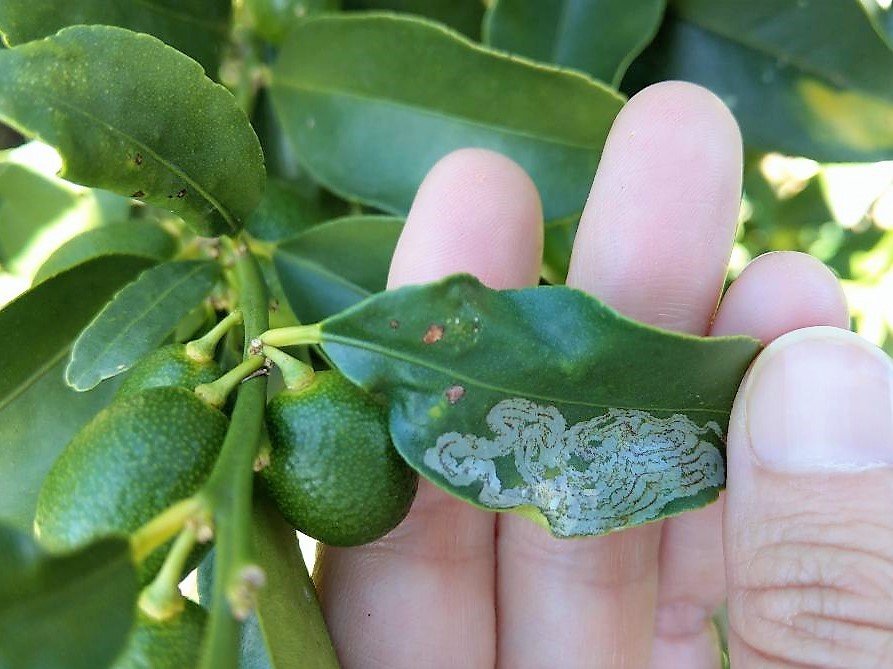
Citrus scale – they look like small brown bumps and can be treated with horticultural neem oil.
Conclusion
Low maintenance food-producing trees are welcome at my place and the kumquat tree makes a wonderful addition to any home garden. Small in size but big on fruit production, once established kumquat trees will look after themselves and reward you in the process.
Recommended Products
- Organic Potting Mix – for planting kumquat trees in pots and containers.
- Organic Citrus Fertilizer –
- Chicken Manure Pellets –
- Horticulture Neem Oil – control kumquat tree pests naturally with neem oil.
- Soil and Water Gauge – monitor soil pH and moisture with this gauge.
Further reading:
- Growing Feijoa Pineapple Guava Trees and Eating Feijoa Fruit
- How To Easily Grow Blueberries At Home
- How To Grow Sensational Strawberries At Home
- Pepino Melon: How To Grow The Plant And Eat The Fruit
- How To Grow A Lemon Tree With Prolific Fruit At Home
- How To Grow Key Limes For Key Lime Pie
- Why is My Kumquat Tree Dropping Fruit (And How To Fix It)
- How to Grow a Persimmon Tree for Delicious Persimmon Fruit
- Why Is My Lime Tree Dying? Causes and Solutions


I have a nagami and a meiwi kumquat tree. They are both fruiting (1/2021) but the completely orange fruit have little flavor. Neither tart nor sweet. They were planted in a pot with potting soil and fertilized regularly. I am in FL so the weather is warm and they get at least 9 hrs of sun daily. I have given them micronutrients. what can be the problem? How can I increase the flavor?
Thanks so much for your question about improving the flavor of your homegrown kumquats. There are a few unknowns here such as the health of the trees, whether they are receiving adequate water, how old the trees are and how long they have been in a pot.
But a few tips would be:
Fertilize seasonally with an organic citrus fertilizer such as this one.
Ensure regular watering. Lack of water can affect the flavor of kumquats.
Kumquat trees in pots can be depleted of essential soil nutrients quickly. Help replenish the soil with a few handfuls of compost (homemade if you have it or store-bought if you don’t) every 3-6 weeks.
By improving the health of the soil, along with regular watering and the great amount of sunlight you have mentioned, you should see an improvement in the flavor of your kumquats.